Assessing countries’ true land restoration potential now possible, says IUCN
The largest landscape restoration initiative in history gained further momentum today - the International Day of Forests - as IUCN and other partners provide the world’s nations with new guidance on assessing their national restoration potential.
Published in the form of a handbook, the Restoration Opportunities Assessment Methodology (ROAM) will help countries understand how much of their land offers restoration opportunities, map where those opportunities are and determine which degraded landscapes offer the most value to society.
“It’s time to move from aspiration to action,” says Julia Marton-Lefèvre, Director-General of IUCN. “We know that there are over two billion hectares of deforested or degraded lands around the world where opportunities for restoration may be found. But before restoration can begin, clear decisions must be made about where the priority landscapes are, what the best mix of restoration interventions will be, and who will bear the costs – and reap the many gains – of long-term restoration and stewardship. The ROAM methodology helps countries answer these questions.”
ROAM, produced by IUCN, the World Resources Institute, and others, also offers a tangible first step for countries interested in committing to the global ‘Bonn Challenge’ goal to restore 150 million hectares of degraded and deforested lands by 2020. With several countries already having made pledges totaling 20 million hectares, the Bonn Challenge represents the largest restoration movement the world has ever
seen.
“It is possible to restore the world’s degraded lands – with a multitude of local-to-global benefits for people and the planet,” says Stewart Maginnis, Global Director of Nature Based Solutions, IUCN. “Countries hoping to join the global restoration movement can now apply a new, flexible method that is based on real experience from national assessments undertaken in Ghana, Guatemala, Mexico and Rwanda. The guide we are publishing today is intended as a ‘road-test’, and we are excited to hear back from countries that will pioneer its implementation, so that we can improve and refine ROAM going forward.”
Restoring landscapes at a national scale delivers multiple benefits to biodiversity and to the economy and helps countries meet global targets in the fight against climate change. With many new Bonn Challenge pledges already in the pipeline, more than a dozen countries are planning restoration opportunity assessments, and are looking to the ROAM methodology to guide them through the process.
The ‘road test’ edition of the guide to the Restoration Opportunities Assessment Methodology (ROAM), is published today with the title “Assessing forest landscape restoration opportunities at the national level” by IUCN and WRI. It provides clear guidance for national teams of any size to undertake detailed and rapid opportunity assessments. The step-by-step methodology is designed to produce an assessment process that is locally adaptable, robust and affordable.
Landscape restoration and ROAM will be discussed at the IUCN World Parks Congress taking place in Sydney, Australia from 12 to 19 November 2014.
The publication
“Assessing forest landscape restoration opportunities at the national level – A guide to the Restoration Opportunities Assessment Methodology” is published today by IUCN .
To download a copy, go to: www.iucn.org/roam
For more information or to speak to one of our experts, please contact:
Aaron Reuben, Communications Officer for Landscape Restoration; Email: aaron.reuben@iucn.org; Tel: + 1 843.670.6084





